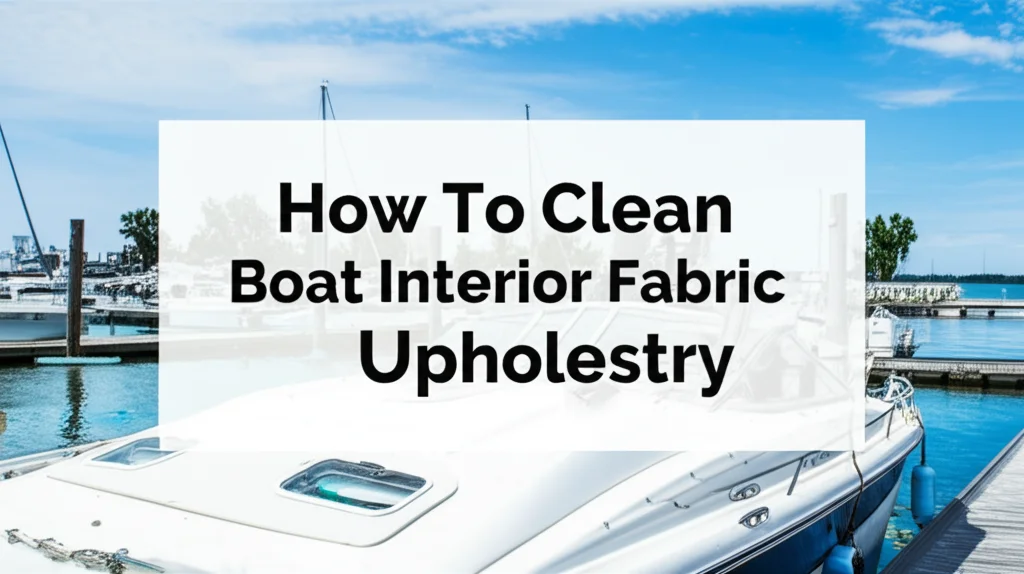· Boating & Marine · 7 min read
How To Clean Boat Interior Fabric Upholstery

Keeping Your Boat’s Interior Fresh: How To Clean Boat Interior Fabric Upholstery
Is your boat’s interior looking a little worse for wear? Boat fabric upholstery faces unique challenges – sun, salt spray, spills, and mildew can quickly take their toll. Cleaning boat interior fabric upholstery regularly isn’t just about appearances; it’s about protecting your investment and ensuring a comfortable experience on the water. This guide will walk you through everything you need to know to effectively clean and maintain your boat’s upholstery, keeping it looking and feeling its best for years to come. We’ll cover everything from choosing the right cleaning products to tackling stubborn stains and preventing future damage.
Takeaway:
- Regular cleaning prevents buildup of dirt and grime.
- Using the right products protects the fabric from damage.
- Proper drying prevents mildew growth.
- Spot cleaning addresses spills immediately.
Quick Answer:
To clean boat interior fabric upholstery, start by vacuuming loose debris. Then, mix a mild soap (like dish soap) with warm water and gently scrub the fabric with a soft brush. Rinse with clean water and allow to air dry completely, ensuring good ventilation to prevent mildew.
Understanding Boat Fabric Upholstery Materials
Before you start cleaning, it’s important to identify the type of fabric you’re dealing with. Different materials require different cleaning approaches. Using the wrong product can cause discoloration, damage, or even complete ruin of your upholstery. Here’s a breakdown of common boat upholstery fabrics:
- Vinyl: This is a popular choice due to its durability and water resistance. It’s relatively easy to clean, but can become brittle with prolonged sun exposure.
- Acrylic Canvas: Known for its resistance to fading and mildew, acrylic canvas is a great option for outdoor use. It’s typically more durable than vinyl but can still stain.
- Polyester: A synthetic fabric that’s affordable and resists shrinking and stretching. However, it’s not as durable as vinyl or acrylic canvas and can be prone to fading.
- Leather/Faux Leather: Offers a luxurious look but requires specialized cleaning and conditioning to prevent cracking and drying.
Always check the manufacturer’s recommendations for cleaning your specific upholstery. You can usually find this information on a tag attached to the fabric. If you’re unsure, test any cleaning solution in an inconspicuous area first.
Gathering Your Cleaning Supplies
Having the right tools and products on hand will make the cleaning process much easier and more effective. Here’s a checklist of what you’ll need to clean boat interior fabric upholstery:
- Vacuum with upholstery attachment: For removing loose dirt and debris.
- Soft-bristled brush: For gentle scrubbing.
- Microfiber cloths: For wiping and drying.
- Mild dish soap: A gentle cleaner for most fabrics.
- Marine-specific upholstery cleaner: Designed for the unique challenges of boat fabrics.
- Bucket: For mixing cleaning solutions.
- Spray bottle: For applying cleaning solutions.
- Clean water: For rinsing.
- Mildew remover (if needed): For tackling mildew stains. You can find effective solutions here.
Avoid using harsh chemicals, abrasive cleaners, or bleach, as these can damage the fabric and cause discoloration.
Step-by-Step Guide to Cleaning Boat Upholstery
Now that you have your supplies, let’s get started with the cleaning process. Follow these steps for best results:
- Vacuum Thoroughly: Begin by vacuuming the entire upholstery surface with an upholstery attachment. This will remove loose dirt, dust, and debris. Pay attention to seams and crevices where dirt can accumulate.
- Prepare Cleaning Solution: Mix a small amount of mild dish soap (about 1 tablespoon) with warm water in a bucket. Alternatively, use a marine-specific upholstery cleaner according to the manufacturer’s instructions.
- Test in an Inconspicuous Area: Before applying the cleaning solution to the entire surface, test it in a hidden area to ensure it doesn’t cause discoloration or damage.
- Apply and Scrub Gently: Dip a soft-bristled brush or microfiber cloth into the cleaning solution and gently scrub the upholstery in a circular motion. Avoid applying too much pressure, as this can damage the fabric.
- Rinse with Clean Water: Use a clean, damp microfiber cloth to rinse the upholstery, removing any remaining soap residue.
- Dry Thoroughly: Allow the upholstery to air dry completely. Ensure good ventilation to prevent mildew growth. You can use fans to speed up the drying process.
Tackling Stubborn Stains on Boat Upholstery
Even with regular cleaning, stains are bound to happen. Here’s how to tackle some common boat upholstery stains:
- Oil and Grease: Sprinkle baking soda on the stain and let it sit for 30 minutes to absorb the oil. Vacuum up the baking soda and then clean the area with a mild soap solution.
- Saltwater Stains: Rinse the area with fresh water and then clean with a mild soap solution.
- Mildew: Mix a solution of water and mildew remover according to the manufacturer’s instructions. Apply to the affected area and let it sit for a few minutes before scrubbing gently and rinsing with clean water. Remember to address mildew promptly to prevent it from spreading.
- Drink Spills: Blot up the spill immediately with a clean cloth. Then, clean the area with a mild soap solution. For stubborn stains, you might need a specialized stain remover. If you’re dealing with tough stains on other surfaces, you might find this guide on removing baking soda residue from carpet helpful for understanding stain removal techniques.
Protecting Your Boat Upholstery from Future Damage
Prevention is key when it comes to maintaining boat upholstery. Here are some tips to protect your investment:
- Regular Cleaning: Clean your upholstery regularly to prevent dirt and grime from building up.
- Use Protective Covers: When your boat is not in use, cover the upholstery with protective covers to shield it from the sun, rain, and other elements.
- Apply UV Protectant: Apply a UV protectant spray to vinyl and acrylic canvas upholstery to help prevent fading and cracking.
- Address Spills Immediately: Clean up spills as soon as they happen to prevent staining.
- Proper Ventilation: Ensure good ventilation to prevent mildew growth.
Maintaining Leather and Faux Leather Upholstery
Leather and faux leather require special care to maintain their appearance and prevent damage. Here’s what you need to know:
- Regular Dusting: Dust the upholstery regularly with a soft cloth to remove dirt and debris.
- Leather Conditioner: Apply a leather conditioner every few months to keep the leather supple and prevent cracking.
- Avoid Harsh Chemicals: Do not use harsh chemicals or abrasive cleaners on leather upholstery.
- Spot Clean Immediately: Clean up spills immediately with a damp cloth.
Keeping your boat’s interior clean and well-maintained will not only enhance its appearance but also extend its lifespan. Remember, a little effort goes a long way in protecting your investment and ensuring a comfortable boating experience. If you’re looking for ways to keep other areas of your boat sparkling, consider learning how to clean vinyl plank flooring for a comprehensive approach to boat maintenance.
Frequently Asked Questions
Q: How often should I clean my boat upholstery?
A: It depends on how often you use your boat and the conditions it’s exposed to. Generally, you should clean your upholstery at least twice a year, or more frequently if it gets heavy use.
Q: Can I use a pressure washer to clean my boat upholstery?
A: No, a pressure washer can damage the fabric. It’s best to use a soft-bristled brush and mild cleaning solution.
Q: What’s the best way to remove mildew from boat upholstery?
A: Mix a solution of water and mildew remover according to the manufacturer’s instructions. Apply to the affected area, let it sit for a few minutes, scrub gently, and rinse with clean water.
Q: How can I prevent mildew from growing on my boat upholstery?
A: Ensure good ventilation, dry the upholstery thoroughly after cleaning, and use a mildew-resistant protectant spray.
Q: Is it safe to use bleach on boat upholstery?
A: No, bleach can damage the fabric and cause discoloration. Avoid using bleach altogether.
Conclusion
Cleaning boat interior fabric upholstery doesn’t have to be a daunting task. By following these simple steps and using the right products, you can keep your boat looking its best for years to come. Remember to identify your fabric type, clean regularly, address spills immediately, and protect your upholstery from the elements. Maintaining a clean and comfortable boat interior will enhance your boating experience and protect your investment. So, grab your supplies and get started – your boat will thank you! Don’t forget that consistent care, like regular cleaning, is the best way to preserve the beauty and longevity of your boat’s interior.
- boat upholstery cleaning
- marine fabric care
- boat interior cleaning




